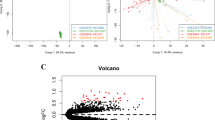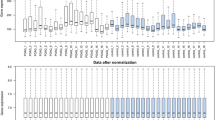Abstract
Glaucoma is a common disorder in which the death of retinal ganglion cells (RGCs) results in a progressive loss of sight, even blindness. This study was performed to reveal the key molecular mechanism of RGC damage in glaucoma based on the Gene Expression Omnibus database. Glaucoma-related microarray datasets were identified, followed by collection of differentially expressed genes (DEGs) with the key genes discovered by weighted gene co-expression network analysis. Through LASSO regression analysis, candidate genes involved in the pathogenesis of glaucoma were identified with their accuracy evaluated by receiver operating characteristic curve analysis. The glaucoma-specific transcriptional regulatory network was constructed to determine the key transcription factor regulatory axis. Then, in vitro cell models were established using H2O2 for further verifying the regulatory role of identified ZFP42/MARK2 axis in RGC damage in glaucoma. Differential analysis of GSE27276, GSE45570, and GSE101727 microarray datasets yielded 165 DEGs, and 22 key genes were identified following. Then, 9 candidate genes involved in the pathogenesis of glaucoma was collected and the key ZFP42/MARK2 regulatory axis was found. In vitro cell experiments further confirmed that ZFP42 and MARK2 were down-regulated in RGCs treated with H2O2. In addition, overexpression of ZFP42 increased the expression of MARK2 to increase RGC cell viability, and reduce cell apoptosis and ROS levels, while silencing MARK2 could reverse the protective effect of ZFP42. We confirmed that ZFP42 reduced the damage of RGCs in glaucoma by up-regulating the expression of MARK2.







Similar content being viewed by others
Data availability
The data and materials of the study can be obtained from the corresponding author upon request.
References
Jonas JB, Aung T, Bourne RR, Bron AM, Ritch R, PandaJonas S (2017) Glaucoma. Lancet 390:2183–2193. https://doi.org/10.1016/S0140-6736(17)31469-1
Kang JM, Tanna AP (2021) Glaucoma. Med Clin N Am 105:493–510. https://doi.org/10.1016/j.mcna.2021.01.004
Weinreb RN, Aung T, Medeiros FA (2014) The pathophysiology and treatment of glaucoma: a review. JAMA 311:1901–1911. https://doi.org/10.1001/jama.2014.3192
McMonnies CW (2017) Glaucoma history and risk factors. J Optom 10:71–78. https://doi.org/10.1016/j.optom.2016.02.003
Conlon R, Saheb H, Ahmed II (2017) Glaucoma treatment trends: a review. Can J ophthalmol J Can d’ophtalmol 52:114–124. https://doi.org/10.1016/j.jcjo.2016.07.013
He S, Stankowska DL, Ellis DZ, Krishnamoorthy RR, Yorio T (2018) Targets of Neuroprotection in Glaucoma. J Ocu Pharmacol Ther 34:85–106. https://doi.org/10.1089/jop.2017.0041
Francois M, Donovan P, Fontaine F (2020) Modulating transcription factor activity: Interfering with protein-protein interaction networks. Sem Cell Dev Biol 99:12–19. https://doi.org/10.1016/j.semcdb.2018.07.019
Feng J, Xu J (2019) Identification of pathogenic genes and transcription factors in glaucoma. Mol Med Rep 20:216–224. https://doi.org/10.3892/mmr.2019.10236
Lee MY, Lu A, Gudas LJ (2010) Transcriptional regulation of Rex1 (zfp42) in normal prostate epithelial cells and prostate cancer cells. J Cell Physiol 224:17–27. https://doi.org/10.1002/jcp.22071
Kristensen DM, Nielsen JE, Skakkebaek NE, Graem N, Jacobsen GK, Rajpert-De Meyts E, Leffers H (2008) Presumed pluripotency markers UTF-1 and REX-1 are expressed in human adult testes and germ cell neoplasms. Hum Reprod 23:775–782. https://doi.org/10.1093/humrep/den010
Kristensen DM, Nielsen JE, Kalisz M, Dalgaard MD, Audouze K, Larsen ME, Jacobsen GK, Horn T, Brunak S, Skakkebaek NE, Leffers H (2010) OCT4 and downstream factors are expressed in human somatic urogenital epithelia and in culture of epididymal spheres. Mol Hum Reprod 16:835–845. https://doi.org/10.1093/molehr/gaq008
Rezende NC, Lee MY, Monette S, Mark W, Lu A, Gudas LJ (2011) Rex1 (Zfp42) null mice show impaired testicular function, abnormal testis morphology, and aberrant gene expression. Dev Biol 356:370–382. https://doi.org/10.1016/j.ydbio.2011.05.664
Matenia D, Mandelkow EM (2009) The tau of MARK: a polarized view of the cytoskeleton. Trends Biochem Sci 34:332–342. https://doi.org/10.1016/j.tibs.2009.03.008
Lee S, Wang JW, Yu W, Lu B (2012) Phospho-dependent ubiquitination and degradation of PAR-1 regulates synaptic morphology and tau-mediated Abeta toxicity in Drosophila. Nat Commun 3:1312. https://doi.org/10.1038/ncomms2278
DiBona VL, Zhu W, Shah MK, Rafalia A, Ben Cheikh H, Crockett DP, Zhang H (2019) Loss of Par1b/MARK2 primes microglia during brain development and enhances their sensitivity to injury. J Neuroinflammation 16:11. https://doi.org/10.1186/s12974-018-1390-3
Rohatgi T, Sedehizade F, Sabel BA, Reiser G (2003) Protease-activated receptor subtype expression in developing eye and adult retina of the rat after optic nerve crush. J Neuroscie Res 73:246–254. https://doi.org/10.1002/jnr.10643
Langfelder P, Horvath S (2008) WGCNA: an R package for weighted correlation network analysis. BMC Bioinformatics 9:559. https://doi.org/10.1186/1471-2105-9-559
Choi H, Choi SJ (2012) Detection of Edwardsiella tarda by fluorometric or biosensor methods using a peptide ligand. Anal Biochem 421:152–157. https://doi.org/10.1016/j.ab.2011.11.012
Wilson AM, Di Polo A (2012) Gene therapy for retinal ganglion cell neuroprotection in glaucoma. Gene Ther 19:127–136. https://doi.org/10.1038/gt.2011.142
You Y, Gupta VK, Li JC, Klistorner A, Graham SL (2013) Optic neuropathies: characteristic features and mechanisms of retinal ganglion cell loss. Rev Neuroscie 24:301–321. https://doi.org/10.1515/revneuro-2013-0003
Wu Y, Zang WD, Jiang W (2014) Functional analysis of differentially expressed genes associated with glaucoma from DNA microarray data. Genet Mol Res 13:9421–9428. https://doi.org/10.4238/2014.November.11.7
Yan X, Yuan F, Chen X, Dong C (2015) Bioinformatics analysis to identify the differentially expressed genes of glaucoma. Mol Med Rep 12:4829–4836. https://doi.org/10.3892/mmr.2015.4030
Bosze B, Moon MS, Kageyama R, Brown NL (2020) Simultaneous requirements for Hes1 in retinal neurogenesis and optic cup-stalk boundary Maintenance. J Neurosci 40:1501–1513. https://doi.org/10.1523/JNEUROSCI.2327-19.2020
Takatsuka K, Hatakeyama J, Bessho Y, Kageyama R (2004) Roles of the bHLH gene Hes1 in retinal morphogenesis. Brain Res 1004:148–155. https://doi.org/10.1016/j.brainres.2004.01.045
Lewis CJ, Hedberg-Buenz A, DeLuca AP, Stone EM, Alward WLM, Fingert JH (2017) Primary congenital and developmental glaucomas. Hum Mol Genet 26:R28–R36. https://doi.org/10.1093/hmg/ddx205
Gualco G, Weiss LM, Bacchi CE (2010) MUM1/IRF4: a review. App Immunohistochem Mol Morphol 18:301–310. https://doi.org/10.1097/PAI.0b013e3181cf1126
Yu CR, Choi JK, Uche AN, Egwuagu CE (2018) Production of IL-35 by Bregs is mediated through binding of BATF-IRF-4-IRF-8 complex to il12a and ebi3 promoter elements. J Leukoc Biolo 104:1147–1157. https://doi.org/10.1002/JLB.3A0218-071RRR
Laino AM, Berry EG, Jagirdar K, Lee KJ, Duffy DL, Soyer HP, Sturm RA (2018) Iris pigmented lesions as a marker of cutaneous melanoma risk: an Australian case-control study. Br J Dermatol 178:1119–1127. https://doi.org/10.1111/bjd.16323
Rani A, Greenlaw R, Runglall M, Jurcevic S, John S (2014) FRA2 is a STAT5 target gene regulated by IL-2 in human CD4 T cells. PLoS ONE 9:e90370. https://doi.org/10.1371/journal.pone.0090370
Sarode P, Zheng X, Giotopoulou GA, Weigert A, Kuenne C, Gunther S, Friedrich A, Gattenlohner S, Stiewe T, Brune B, Grimminger F, Stathopoulos GT, Pullamsetti SS, Seeger W, Savai R (2020) Reprogramming of tumor-associated macrophages by targeting beta-catenin/FOSL2/ARID5A signaling: a potential treatment of lung cancer. Sci Adv 6:eaaz6105. https://doi.org/10.1126/sciadv.aaz6105
Chen M, Huang B, Zhu L, Chen K, Liu M, Zhong C (2020) Structural and functional overview of TEAD4 in cancer biology. Onco Targets Ther 13:9865–9874. https://doi.org/10.2147/OTT.S266649
Appukuttan B, McFarland TJ, Davies MH, Atchaneeyasakul LO, Zhang Y, Babra B, Pan Y, Rosenbaum JT, Acott T, Powers MR, Stout JT (2007) Identification of novel alternatively spliced isoforms of RTEF-1 within human ocular vascular endothelial cells and murine retina. Invest Ophthalmol Vis Sci 48:3775–3782. https://doi.org/10.1167/iovs.06-1172
Mongan NP, Martin KM, Gudas LJ (2006) The putative human stem cell marker, Rex-1 (Zfp42): structural classification and expression in normal human epithelial and carcinoma cell cultures. Mol Carcinog 45:887–900. https://doi.org/10.1002/mc.20186
Almasieh M, Wilson AM, Morquette B, Cueva Vargas JL, Di Polo A (2012) The molecular basis of retinal ganglion cell death in glaucoma. Prog Retin Eye Res 31:152–181. https://doi.org/10.1016/j.preteyeres.2011.11.002
Kanamori A, Catrinescu MM, Kanamori N, Mears KA, Beaubien R, Levin LA (2010) Superoxide is an associated signal for apoptosis in axonal injury. Brain 133:2612–2625. https://doi.org/10.1093/brain/awq105
Agrawal V, Johnson SA, Reing J, Zhang L, Tottey S, Wang G, Hirschi KK, Braunhut S, Gudas LJ, Badylak SF (2010) Epimorphic regeneration approach to tissue replacement in adult mammals. Proc Natl Acad Sci USA 107:3351–3355. https://doi.org/10.1073/pnas.0905851106
Wang G, Badylak SF, Heber-Katz E, Braunhut SJ, Gudas LJ (2010) The effects of DNA methyltransferase inhibitors and histone deacetylase inhibitors on digit regeneration in mice. Regen Med 5:201–220. https://doi.org/10.2217/rme.09.91
Luk ST, Ng KY, Zhou L, Tong M, Wong TL, Yu H, Lo CM, Man K, Guan XY, Lee TK, Ma S (2020) Deficiency in embryonic stem cell marker reduced expression 1 activates mitogen-activated protein kinase kinase 6-dependent p38 mitogen-activated protein kinase signaling to drive hepatocarcinogenesis. Hepatology 72:183–197. https://doi.org/10.1002/hep.31020
Kreutter G, Kassem M, El Habhab A, Baltzinger P, Abbas M, Boisrame-Helms J, Amoura L, Peluso J, Yver B, Fatiha Z, Ubeaud-Sequier G, Kessler L, Toti F (2017) Endothelial microparticles released by activated protein C protect beta cells through EPCR/PAR1 and annexin A1/FPR2 pathways in islets. J Cell Mol Med 21:2759–2772. https://doi.org/10.1111/jcmm.13191
Acknowledgements
Not applicable.
Funding
None.
Author information
Authors and Affiliations
Contributions
YY and SW designed the study. SW, LZN and SWH collated the data, carried out data analyses and produced the initial draft of the manuscript. YY and SWH contributed to drafting the manuscript. All authors have read and approved the final submitted manuscript.
Corresponding author
Ethics declarations
Conflict of interest
The authors declare no competing interest.
Ethical approval
Not applicable.
Consent for publication
Not applicable.
Additional information
Publisher's Note
Springer Nature remains neutral with regard to jurisdictional claims in published maps and institutional affiliations.
Supplementary Information
Below is the link to the electronic supplementary material.
Rights and permissions
Springer Nature or its licensor holds exclusive rights to this article under a publishing agreement with the author(s) or other rightsholder(s); author self-archiving of the accepted manuscript version of this article is solely governed by the terms of such publishing agreement and applicable law.
About this article
Cite this article
Yin, Y., Wu, S., Niu, L. et al. A ZFP42/MARK2 regulatory network reduces the damage of retinal ganglion cells in glaucoma: a study based on GEO dataset and in vitro experiments. Apoptosis 27, 1049–1059 (2022). https://doi.org/10.1007/s10495-022-01746-9
Accepted:
Published:
Issue Date:
DOI: https://doi.org/10.1007/s10495-022-01746-9




